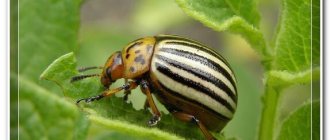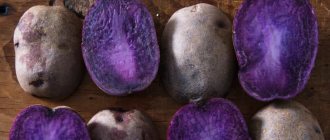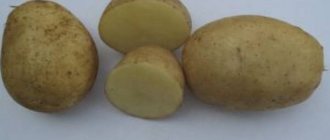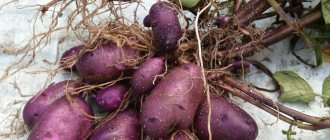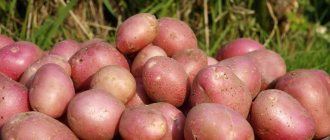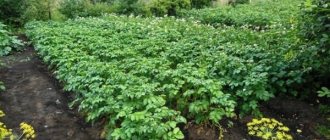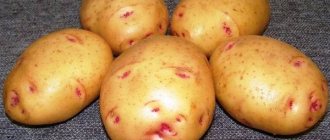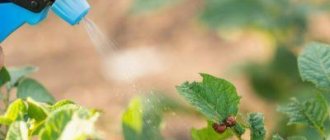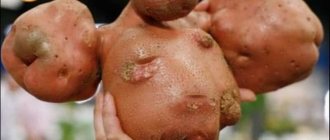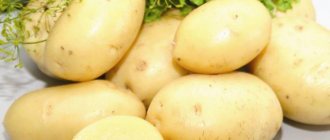Classification of potatoes by skin and pulp color
Depending on the variety, the potato flesh can be white or yellow, and the skin can be white, yellow, red or purple. The yellow color of the pulp indicates a high content of beta-carotene in the tubers. The red color of the peel is given by anthocyanins - bioflavonoids that have an antioxidant effect and strengthen the walls of blood vessels. The darker the skin of the tubers, the more anthocyanins it contains. That is why it is recommended to use pink potato juice for medicinal purposes.
Latest articles for gardeners, gardeners and flower growers
How to grow petunia from seeds at home for seedlings
Planting carrots in spring sowing when to sow how to plant correctly
When to plant zinnia seedlings in 2021 according to the lunar calendar
Pruning an apple tree in spring for beginners in pictures step by step
Recently, breeders around the world have been working on developing potato varieties with red and purple flesh. This is not a whim: of course, such tubers look impressive, but the high content of anthocyanins makes such potatoes an indispensable dietary product, especially for people with diseases of the cardiovascular system.
Tips for harvesting and storing crops
Harvest dates vary depending on the selected variety and the climatic characteristics of the region. However, the maturity of tubers can be easily determined by the degree of wilting of the tops. After digging, the potatoes are rejected and sorted by size. Tubers with signs of rot are removed, and in the presence of any mechanical damage (scratches, cuts) they are used as food first.
Important! To increase shelf life, potatoes are treated with a solution of copper sulfate (2 g per 1 bucket of water).
The room in which potatoes are planned to be stored should be dry and dark, and the temperature should be within +2...+4°C. Tubers are stored well in boxes with holes, or in bins. The main condition is uninterrupted access of oxygen and the possibility of free evaporation of moisture.
To summarize, it is worth noting that yellow potatoes enjoy a well-deserved reputation among gardeners in various regions. Due to its high taste, dense pulp structure and ease of care, this variety of potato is often chosen as the main one in the garden beds by both experienced vegetable growers and beginners.
Amorosa potatoes photo and description
A mid-early representative belonging to the table category. During cultivation it requires sufficient water supply. The tubers are round-oval in shape, large, the skin is red, the flesh is light yellow, the eyes are small.
It is distinguished by high yield and taste. Potatoes are in good presentation. The tubers are elongated oval, large, the skin is red and the flesh is yellow. The variety is resistant to leaf curl, viruses, tuber blight, and potato nematode. Lower resistance to common scab. Weak resistance to late blight of tops and some viruses.
Description
The main distinctive feature of the yellow potato variety is the increased content of carotene, which helps improve vision, skin condition and prevents rapid aging.
The shade of the pulp appeared due to the vitamin A content in the product. Experts say that potatoes with a rich yellow tint of pulp are much healthier than white tubers.
Vegetable varieties that are yellow inside
Note! Yellow varieties of tuberous herbaceous plants have a pleasant taste.
Potatoes Ariel photo and description
The existing variety of potato types is explained by constant work to improve growing technology and increase the yield of the vegetable. One of the varieties that deserves attention is the Dutch variety Ariel. It has almost no flaws and is easy to care for. Residents of warm regions appreciated it for the size and mass of root crops, the possibility of double harvesting and the longest possible storage.
Stores well. Fruits abundantly - 22 - 49 tons per 1 ha. You can harvest 2 crops in 1 season. Does not darken after heat treatment. Medium height plant. The tubers are yellow both outside and inside. May be affected by late blight and scab. The color of the peel is beige, the tuber is pale yellow.
It is recommended to change the area for planting Ariel potatoes every couple of years. This will reduce the likelihood of diseases and increase harvest. To obtain 2 potato harvests per season, you need to respect the timing of both plantings. As a rule, this is the beginning of May and July. It is better to germinate potatoes after treating them with a special solution (biostimulator).
The variety is practically not affected by viruses; with good care, it is resistant to blackleg and various rots. Early ripening protects potatoes from late blight infection. It is not afraid of typical nightshade diseases:
- Potato cancer;
- Golden cyst nematode;
- Common scab;
- Curling of leaves.
Potato resistance to diseases and pests should be maintained by observing the following steps. This includes treating tubers before planting, rational crop rotation, timely and sufficient watering, and preventive spraying against late blight.
The most delicious yellow potatoes
Varieties of potatoes with yellow flesh: description, photos, reviews
Such potatoes usually boil well and have excellent taste. Which varieties of yellow potatoes are the most popular and which are the most delicious? Let's look at some types of such potatoes.
The most common table varieties of yellow potatoes have tender flesh, do not darken, contain 12–16% starch, and are rich in vitamin C. Their tubers are mostly round or oval, with superficial eyes.
Yellow potato variety Adretta, description
This is a mid-season potato variety of German selection, intended for table use. Adretta has a wonderful pulp taste. The plant is erect, the leaves are light green. The corolla of the flower is white. The tubers are round-oval in shape with small eyes. The average weight of a tuber is 100-150 g. The pulp is yellow and does not darken during heat treatment and cutting.
The variety has early tuberization. Resistant to late blight, relatively resistant to viral diseases.
Potatoes Anosta, characteristics
Early ripening, Dutch, table potato variety. The harvest is formed 55-65 days after the seed tubers emerge. The growing season is 80-90 days.
The tubers are light yellow, round-oval in shape, yellow flesh. The average tuber weight is 70-140 g. Starch content is 12.7-15.0%. Protein content 1.3-1.9%. The taste and safety of the tubers are satisfactory. The yield of the Anosta variety is above average.
Disadvantages of the variety: not resistant to late blight of tops and moderately resistant to tubers. Moderately affected by common scab and viral diseases.
Yellow potatoes Impala, photo
An early-ripening table potato variety. It is popular due to its stable high yield (550 to 620 c/ha) in the Central and Southern regions of Russia.
Tubers with smooth yellow skin, small eyes and light yellow, very tasty pulp. The average tuber weight is 90-150 grams.
Advantages of the variety: Impala potatoes store well, are resistant to potato cancer and golden potato nematode.
Red Scarlet, characteristics
Early ripening, one of the best red-skinned table potato varieties. Especially popular in the Central and Southern regions of Russia.
The variety's yield is high: 400-660 c/ha. The tubers are large, with an average weight of 80-120 g, beautiful, with smooth red skin, small eyes and yellow flesh. The pulp does not darken when cut and does not change color after cooking.
Advantages of Red Scarlet potatoes: tolerates drought well, is resistant to potato cancer, golden potato nematode, late blight, leaf curl and viral diseases.
Amorosa potatoes, description, photo
A mid-early, productive variety of table potatoes, it has excellent taste and good presentation.
The tubers are elongated, oval-shaped, large, with red skin and yellow flesh. Dry matter content - 19.5.
The variety is resistant to leaf curl, potato nematode, and late blight of tubers. Moderately resistant to common scab. Weakly resistant to late blight of tops.
Marfona potatoes: characteristics, photos
Mid-early variety of table potatoes. The tubers are uniform, beautiful, with eyes of medium depth.
The tubers are oval-shaped, large, with yellow skin and light yellow flesh. Dry matter content - 18.7.
The variety tolerates heat easily, stores well, and is resistant to mechanical damage. Doesn't boil over. Resistant to viruses and tuber blight. Moderately resistant to leaf curl and common scab. Not resistant to potato nematode.
Potato Odysseus, description
Zoned in the Central and Central Black Earth regions. The tubers are oval-round, with yellow skin and yellow starchy pulp. These potatoes are perfect for making mashed potatoes, jacket potatoes, French fries, soups, potato pancakes, etc. Boiled tubers have an excellent taste and do not darken.
The variety has complex resistance to potato diseases. Maximum yield - 300 c/ha.
Potatoes Santa, description, photo
Mid-early (80-90 days from germination to first harvest), high-yielding variety from the Dutch company Agrico. These are potatoes for table use, as well as for making French fries and chips. Sante is the most productive variety, which requires greater distance between rows and plants when grown.
The tubers of this variety are oval and large. The peel is yellow, smooth. The pulp is light yellow and does not darken when cut. The eyes are small and numerous. The starch content in tubers is 10-14.2%. The taste is excellent.
Advantages of the Sante variety : high yield, excellent taste, satisfactory degree of immunity to diseases. Potatoes of this variety have good marketability and storage quality.
Interesting on the topic:
Bellarosa potatoes photo and description
The Bellarosa variety is still popularly called a rose. Refer to earlier varieties with a higher yield percentage. Potatoes got their name because of their fruits. It has a reddish-pink or soft pink tint. During the period of potato growth, the bush is colored red-violet and has light yellow flesh. Many chefs note very good taste. This in turn makes the Bellarosa variety very popular in the trade.
Latest articles for gardeners, gardeners and flower growers
Ammonia in the garden application for strawberries
Feeding tomato and pepper seedlings with folk remedies
Lunar sowing calendar for 2021 gardener table
Pruning raspberries in spring: how to do it correctly
The average yield level usually exceeds 330 c/ha. Potatoes are smooth and do not become stained during storage. Main advantages: Excellent external characteristics of potatoes. Good level of survival in various types of soils. Can fully ripen in 70 days. Unlike other types of potatoes, bellarosa can perfectly tolerate different types of diseases and viruses.
Bellarosa
One of the youngest varieties, which became widespread only in the early 2000s. More suitable for the temperate climate of Eastern Europe. Undemanding to soil composition and temperature changes. The tubers are round, reddish in color, with a slight roughness. Even after heat treatment, potatoes retain excellent taste. During the tests, the variety's resistance to scab, potato cancer, rhizoctonia, blackleg, late blight, etc. was confirmed. The lucky ones who are already familiar with the variety note the high yield and resistance of Bellarosa to mechanical damage.
| Purpose | Productivity (kg/100 sq.m) | Tuber weight (g) | Maturation (days) | Flesh color | |
| 200-350 | 170-200 | 50-60 | Creamy yellow to yellow | ||
Potato Breeze photo and description
From planting the seed in the ground to harvesting, 70-80 days pass. Plants are semi-erect, intermediate type, and have an average height. The stem is thin with barely noticeable or completely absent anthocyanin coloring. The leaves are of intermediate type, large, closed, dark green in color; the edge of the leaf blade is slightly wavy. The leaf lobes are medium, matte, there is no ivy. Medium sized inflorescences. The flower is white, without anthocyanin coloring on the inside of the colored flower.
Breeze potatoes have early tuberization - they quickly accumulate a marketable crop in the first half of the growing season. Responsive to increasing background mineral nutrition. Suitable for cultivation on all types of soil. The tubers are oval-shaped, large in size, with yellow flesh. The skin is yellow, medium smooth (weakly mesh). The eyes are medium-sized, medium-deep (depth - 1.1 - 1.3 mm). The light sprout is conical in shape. The base of the light sprout is red-violet in color, slightly pubescent.
The weight of a commercial tuber is 100 - 150 grams. Marketable yield is 160 - 395 c/ha, which is at the level of the standard Elizaveta variety. The maximum yield is 450 c/ha, which is 30 c/ha higher than the Sante standard (data for the Kaliningrad region). Marketability 83 - 98%. Keeping quality 97%. A table variety with good taste. Suitable for preparing boiled and mashed potatoes, dry peeling (or washing) and packaging. Tasting score for boiled potatoes: 7 points. The boilability of the tuber pulp is weak. The starch content is 10 - 16%, dry matter in tubers - 20.1%, reducing sugars - 0.21%.
Potato Breeze is characterized by high resistance to leaf curl, wrinkled and striped mosaic, the causative agent of potato cancer (pathotype 1), and viruses (X, S, M, Y). Moderately resistant to common scab, blackleg, rhizoctonia and late blight of tops and tubers. However, it is weakly resistant to golden potato cyst nematode.
Basic rules for planting and care
When choosing one of the varieties of yellow potatoes, you should adhere to the basic rules of planting and subsequent care of the vegetable crop. When choosing the optimal time for planting, you should not rely on established traditions of planting potatoes in early May, since they will not always be correct.
Being a heat-loving crop, potatoes planted in unheated soil may either not produce the expected harvest or die altogether. The level of humidity plays an important role - elevated levels can provoke putrefactive lesions.
Important! When planting, many vegetable growers rely on the data of the lunar calendar. However, the fact that the moon influences the growth of planted plants has not been scientifically confirmed.
You can always determine the most suitable time frame yourself - after spring frosts, you need to wait until the soil warms up to +7...+8 ° C to a depth of about 10 cm. There is also a folk sign: the most suitable period will be the time between the flowering of bird cherry and the appearance of foliage on the birch tree ( about 7 days).
The area for potatoes should be flat and not shaded, since the harvest will depend on the amount of sunlight. It is recommended to apply crop rotation rules - this will protect plants from diseases. Any crops except nightshades are considered as optimal predecessors.
The soil for planting is prepared in the fall - it is plowed to a depth of 30 cm, cleared of weeds, fertilized with organic matter and complex mineral fertilizers. In the spring, fertilizing is repeated, but with nitrogen fertilizers. There are a large number of planting technologies that are adapted to the climatic characteristics of different regions.
Also familiarize yourself with the features of applying fertilizers for potatoes when planting.
The most popular among them are:
- Ridge planting is the most suitable technique for regions that experience frequent and heavy rainfall, and for planting in clay soils, since sandy and sandy loam soils will need frequent watering.
- Planting in trenches - the method consists of preliminary preparation of furrows, the bottom of which is covered with organic matter (manure, compost, ash or hay). This technology will ensure a stable level of moisture and eliminates the need for additional soil fertilization. However, in the event of prolonged rains, there is a possibility of rotting processes occurring, and therefore this planting method is used only in regions with arid climates.
- Planting in double beds - planting is carried out in a checkerboard pattern, which provides better illumination of the above-ground part of the plant and more space for the development of rhizomes. Such conditions increase the quality and quantity of fruiting.
- Planting using the Mittlider method - the essence of the technology is the formation of narrow beds and wide row spacing. Such conditions are optimal for the formation of potato nests and significantly reduce labor costs when weeding.
However, despite the wide choice of technologies, one of the most popular methods of planting potatoes has been and remains the “shovel” method, which involves planting in rows:
- after plowing and fertilizing, the edges of the beds are measured with stakes;
- the distance between the holes is about 30 cm, the depth depends on the soil (sandy loam soil - 7-10 cm, loamy soil - 5-7 cm);
- planting material and fertilizer are placed in each hole;
- the hole is filled with soil.
Row spacing is about 70 cm, but if early varieties are grown, this distance can be somewhat reduced.
Important! When reducing the distance between rows, one should take into account the need for systematic hilling, the soil for which is taken from the row spacing. If you leave too little space, the plant's roots may be damaged.
Once planted, potatoes will need constant watering. Depending on weather and climatic conditions, as well as air temperature, the frequency of watering per month can vary from 3 times (subject to cool temperatures) to 6 (in hot conditions), and the volume of water for each bush - from 5 to 12 liters. Also, the volume of water will be affected by the structure of the soil - heavy and dense soils need watering much less often. It is best to add moisture in the evening.
It is necessary to take into account some features of this culture:
- the suction roots of potatoes have a very thin structure, and therefore it is best to preheat the water for irrigation during the day in the sun;
- during the budding period, the frequency of watering increases to three times a week, in the amount of 5 liters per bush;
- in conditions of elevated temperatures, the soil must be loosened and mulched - this will help maintain moisture at the required level;
- The potatoes are watered for the first time after the tops appear, the height of which reaches 10 cm.
Potatoes require fertilizer:
- The first fertilizing is carried out approximately a week after sowing the planting material. For these purposes, mullein is used (1/2 kg of manure is diluted in a bucket of water) or a solution of chicken manure (1 tablespoon of fertilizer is diluted in 1 bucket of water). 0.5 liters of fertilizer is poured under each plant.
- The second time, fertilizing is applied at the stage of formation and formation of tubers. During this period, complex mineral fertilizers will be required.
- The third is applied 3 weeks before harvest using 0.5 liters of manure solution and a solution of superphosphates (20–30 g diluted in 10 liters of water).
Read more about how and how to properly process potatoes.
During the entire growing season, potato beds must be cleared of weeds. Also, to increase oxygen access, loosening is recommended after each watering. Stagnant water caused by irregular loosening can cause fungal diseases. To combat these diseases, treatment with stimulants and growth regulators is used during the flowering period of the crop, as well as with a 0.2% solution of metal complexonates at the budding stage.
The most common pest that destroys potato tops is the Colorado potato beetle. To destroy it, manual collection is used (if the number is low), the use of environmental preparations (infusion of walnut leaves, wormwood, etc.), as well as treatment of plants with insecticidal preparations (when the larvae develop to 2–3 instars).
Potatoes Impala photo and description
The Impala potato variety is characterized by high yield, resistance to most diseases, and its fruiting does not depend on the vagaries of the weather. One of the main advantages of this potato is its early ripening; it is not for nothing that its name is translated as “fast antelope.”
Latest articles for gardeners, gardeners and flower growers
Treatment of seeds with phytosporin before planting
Tomato varieties resistant to late blight for open ground
Pepper seedlings at home without picking
Treating seeds with hydrogen peroxide before sowing
The Impala potato was bred by breeders from the Netherlands, who tried to create a new variety with improved productivity and early ripening characteristics. As a result, this potato has been popular with many vegetable growers from around the world for more than 10 years and is also grown on an industrial scale.
In Russia, the Impala variety was included in the State Register in 1995 and zoned for cultivation in the Volga-Vyatka, Lower Volga, North-Western and Central regions. Also, these potatoes were included in the State Registers of Ukraine and Belarus after 5 years.
Experts classify these potatoes as early-ripening varieties. But we can say for sure: from the moment the sprouts appear until the harvest, a little more than 2 months pass, but you can dig up early potatoes after 1.5 months.
The bushes of the variety are quite tall (about 0.7 m), dense, and well-leafed. In total, at least 5 shoots grow on each plant. The foliage is medium in size, its edges are slightly wavy, the color is rich emerald. The blooming flowers are white with a yellow center.
The tubers are oval, smooth with small eyes that lie shallow. The skin is smooth, yellowish in color. The average weight of Impala potato root crops is 125-150 g, the color of the pulp is light yellow.
Santa (Sante)
An excellent variety for both beginners and experienced gardeners. The first Dutch sample whose complex resistance to viruses was officially recognized. The only small “whim” of Santa is his demands on soil temperature. The variety is very heat-loving, so it is zoned mainly in Moldova, Ukraine and southern Russia. The tubers are light yellow in color. The yield is high, as is the taste. The variety is perfectly stored in any conditions and does not lose its attractive appearance.
| Purpose | Productivity (kg/100 sq.m) | Tuber weight (g) | Maturation (days) | Flesh color | |
| 500-550 | 70-90 | 80-90 | Light yellow | ||
The most productive
Idaho
The advantages of this variety are that it is early ripening, ripens in 60-70 days, in addition, the variety gives a high yield - up to 550 c/ha, even when grown at home.
The variety exhibits good disease resistance and ripens quickly, which is why it is very popular among Russian gardeners, despite the fact that it is of American origin.
The fruit contains a lot of starch and carbohydrates and is not watery, so these potatoes are healthy and nutritious.
Characteristic:
- Early ripening (60-70 days).
- High yield (550 c/ha).
- Fruit color - beige
- The pulp is boiled.
- It is resistant to nematode diseases and cancer and blooms before the Colorado potato beetle invasion.
- Starch concentration - up to 17%.
An early-ripening, high-yielding variety (70-80 days) with large fruits of regular oval shape and light brown color. Has excellent taste. In the southern regions of Russia, you can grow 2 crops per season.
Characteristic:
- Early ripening (70-80 days).
- High yield - up to 350 c/ha with proper watering and fertilizing.
- The peel is red.
- The pulp is light yellow.
- Starch concentration - 19%.
- During cooking, the pulp becomes crumbly.
- The average fruit weighs about 200 g, but there are specimens up to 500-600 g, especially with proper watering.
- Resistant to nematodes and cancer pathogens. When the Colorado potato beetle appears, this variety already has time to bloom.
- Keeping quality - 93%.
Rosara
Early, the fruits reach technical ripeness in 76 days. The fruits are red or brown. The bushes are large, growing up to 70 cm in height. The stems are thick and strong.
Characteristic:
- Early ripening (70-80 days).
- High yield - up to 290-320 c/ha, but with proper watering and fertilizing you can get 530 c/ha.
- Peel color is red.
- The color of the pulp is yellow.
- Starch concentration - 13 - 17.5%.
- The average fruit weighs about 150 g, but there can be about 20-30 pieces under the bush.
- Resistant to powdery mildew and fungal diseases, nematodes and cancer. Weakly affected by scab and late blight.
A mid-early variety, the fruits reach technical ripeness in 60-68 days. Vegetables are large, elongated oval, yellow in color. The bushes grow up to 45-50 cm in height, have thin stems that sometimes turn yellow. To maintain the plant, it must be fertilized frequently.
Characteristic:
- Average early ripening is 60-68 days.
- High yield - 340 c/ha.
- Peel color is yellow.
- The color of the pulp is dark yellow.
- Starch concentration – 10 -13%.
- The fruit can weigh about 400 g, there can be about 4-5 pieces under the bush. With proper feeding, vegetables can be even larger.
- Resistant to cancer and nematode.
- May be susceptible to late blight and rhizoctonia.
- Not afraid of mechanical damage.
- Keeping quality - 90%.
An elite variety that requires care - it is necessary to regularly water the plants and fertilize frequently. Early ripening, vegetables reach technical ripeness in 70-80 days. With proper watering, it tolerates cold and heat well.
Characteristic:
- Early ripening (70-80 days).
- High yield - 560 c/ha.
- Peel color is beige.
- The color of the pulp is white; Starch concentration – 14%.
- The average weight is 180 g, but the fruit can weigh about 400 g and even 600 g. The bush contains about 25 tubers.
- Resistant to late blight.
- The lightness is high, it is stored for about 7-9 months.
All the varieties described above produce above average yields. However, in order to get record yields, the bushes of the crop must be cared for according to all the rules of agricultural technology.
